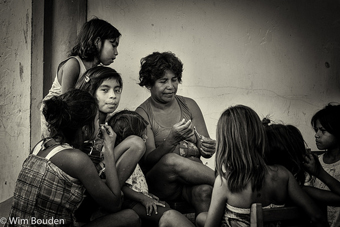
Why Is Giving Internationally Important?
by Beth Ellen Holimon, DFW Executive Director
Philanthropic reports tell the story that Americans are among the most generous in the world. Private giving exceeded $358 billion in 2014 with individuals giving 72%, foundations giving 14%, bequests 8% and corporations at 5%. The only category of giving to decline in 2014 was international giving, making it the third year in a row that giving has dropped in this category.
While the drop in international giving does not reflect trends at Dining for Women, I am frequently asked if DFW will ever give to organizations that benefit women and girls within the United States. I know that this desire comes from the fact that DFW has such a fabulous model of combining member transformation, education, and collective giving that many of us want to extend this to the enormous needs in our own communities. However, our unwavering focus on our mission to “invest in programs that make a meaningful difference for women and girls in developing countries” is one of the reasons that DFW is so successful, despite giving trends, and that our donors trust and give every month. I feel confident in saying that most of our members give locally and globally and we want that to continue.
Since DFW began, we based our investments on the fact that creating equity for women and girls is the key to ending root poverty. We also know that small investments make a big impact. Consider these statistics from the U.S. Agency for International Development (USAID):
- 99% of maternal deaths occur in the developing world.
- Adequate health care, a skilled birth attendant and emergency care help prevent maternal deaths.
- 1 in 5 girls in developing countries who enroll in primary school never finish.
- When 10% more girls go to school, a country’s GDP increases on average by 3%.
- 1 in 7 girls will marry before they are 15 in the developing world.
- Girls who stay in school for seven or more years marry four years later and have two fewer children.
- Women make up nearly 52% of the global total of people living with HIV.
- Current approaches to preventing mother-to-child HIV transmissions are 98% effective.
- Women make up 43% of the agriculture labor force. However, women are less likely to own land, and own fewer amounts of land when they do.
- When women have the same amount of land as men, there is over 10% increase in crop yields.
- Women comprise only 18.9% of the world’s legislators.
- Countries where women’s share of seats in political bodies is greater than 30% are more inclusive, egalitarian, and democratic.
These are all excellent examples of how giving internationally and investing in women and girls can help change the world! Unfortunately, each year an average of only 7% of all philanthropic dollars in the U.S. are allocated to address needs specific to women and girls. This is frustrating when we know that this is exactly where philanthropic dollars SHOULD be invested to address root causes. We know that programs and policies that benefit women and girls improve maternal and child health outcomes, break the cycle of violence against women, eliminate barriers to women engaging in leadership opportunities, and end the cycle of intergenerational poverty experienced in developing countries.
Fortunately, this is exactly what Dining for Women is doing – with your support. As you look at our past programs and the new slate of organizations that DFW members will fund in 2016, you will see that we ARE collectively making a difference for women and girls in developing countries. Dining for Women is bucking the philanthropic trends to make a big impact and you can count on DFW to remain true to our mission so we are all part of creating lasting change in the world.
Sources for Statistics:
http://www.genevaglobal.com/download/55
http://www.nptrust.org/philanthropic-resources/charitable-giving-statistics/
https://www.usaid.gov/what-we-do/gender-equality-and-womens-empowerment
